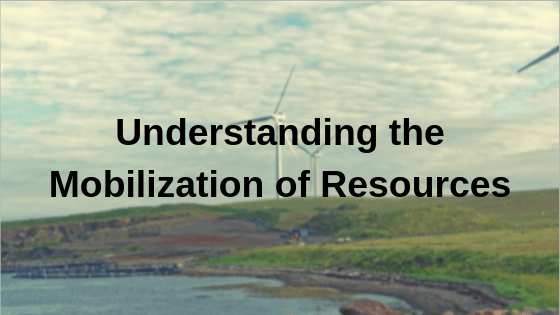Mobilization of resources is a key topic under Indian Economy for the IAS examination. In this article, we will cover the definition, major features, types and issues pertaining to mobilization of resources.
Domestic resources can be defined as the economic resources that are present within the territory of any country. These resources, irrespective of their presence and potential are not collectively utilized. This, in turn, leads to a disparity between the estimated potential of those resources and their actual use.
For any country to prosper, it is of immense importance that their resources are effectively identified and mobilized.
So, how do we identify these resources?
Types of Resources of India
When discussing important economic resources in india, they can be divided into three major categories :-
Natural Resources
Examples of natural resources include petroleum, water, natural gas, coal, etc.,
Human Resources
Examples of human resources include the intellectual capacity of the nation, as well as the labour force.
Financial Resources
Examples of financial resources are monetary income generated through taxation policies.
What is Resource Mobilization?
- In the simplest of terms, Resource Mobilization, for a government or a non-government organization, is the identification, organization and utilization of the available material resources within the country (including financial resources) to further its objectives of development missions and plans.
- In accordance to a government, mobilization of resources is essentially efficient collection of funds and effective allocation of the above resources to multiple development schemes and plans.
- It is the process of making unavailable or locked resources free for use with the motive of attaining a collective goal.
- Mobilization of resources involves a series of systematic steps that must be implemented to acquire various useful resources in a cost-effective and timely manner.
- The objective behind the process is optimal utilization of the resources, i.e., to have the right resources at the right time, available at the right price and used exclusively for the right purpose.
Why is Resource Mobilization so Important?
- It is helpful in maintaining Organizational Sustainability.
- It keeps a check and guarantees continuation of the organization’s (government or non-government) service provision.
- It paves the way for improvement of the available services and products.
- It supports the expansion of the organization’s products and services.
- It is crucial to any organizations existence, as any organization, be it in the public sector or private sector, must continually generate new business to maintain a perpetual presence.
Now, let us understand in detail how the major resources of the economy are mobilized : –
Mobilization of Natural Resources
- In the present day indian economy, mobilization of natural resources has garnered much attention despite the fact that there is abundance of natural reserves within its geographic limits.
- The main reason behind the under-utilization of these plentiful resources are the policy hold-ups that hinder the process.
- We import iron and coal, which in turn increases the current account deficit.
Mobilization of Financial Resources
- The production in a country is carried on in its private sector, public sector, or in PPP.
- The production of these goods and services is essential for the economy to grow.
- Studies show Indians invest more into consumer durable and gold. Moreover, the savings rate is good yet we have a low domestic investment.
- If the objective of economic growth must be achieved, there should be more investment in services, agriculture and manufacturing.
- Ideally in a modern capitalistic economy, these are ‘free-flowing’, and comparatively easier to mobilize than in the traditional economy.
- Initial Resource Mix – technology, labor organizational structure, capital support, etc, are few of the multitudes of resources required to begin any organization. It is not necessary that the right mixture of the required resources is always available.
- Manpower or people are the most significant resource of any organization.
- The four factor a production, vis a vis, labor, land, organization and capital must be combined to create the right atmosphere of investment and growth.
- The existent taxation base is small, and must be widened.
Mobilization of Human Resources
- Human resource is the potential of the people in a country
- Human resources are crucial and must be prepared for ready use. With such a significant population at its disposal, India has started to focus much on mobilizing its human resources.
- Human resources mobilization is clearly the empowerment of the human resources.
- The more backward and weaker sections including SC,ST,OBC,women and children, etc, must be brought to the forefront.
- There is a need for skill development programs for imparting necessary vocational skills.
- More employment opportunities must be created that suit the population’s skillset.
- There is an increasing need to utilize the huge demographic dividend.
- The Technologists, including the scientists, engineers and doctors are being given more weightage in india
The Major Issues with Mobilization of Resources
The significant drawbacks highlighting the Human resources, the Financial resources and natural resources affect the overall Mobilization of resources in a nation.
- Low – income countries are in a state of perpetual struggle with poverty. In such a situation, resource mobilization can be a challenge. This is a major reason why a majority of developing economies rely on Foreign direct investment, export earnings, foreign aid, and other external sources.
- If a consistent and significant economic growth must be achieved, it is vital to decrease the rate of poverty in the economy.
- A strong foundational support for uninterrupted sustainable development must also be attained.
- In economies characterized by a high-growth rate, it is observed that an average of 20-30 percent or more of the income is saved to finance the private and public investment.
- Domestic resource mobilization is highly compatible with the domestic ownership, and not with external resources.
- Foreign aid comes with its fair share of restrictions and conditions.
- While foreign direct investment is helpful in attainment of commercial objectives of the concerned investor, it does little for the host country’s developmental plans.
Mobilization of resources is any day more predictable and dependable than foreign direct investment, external aid and export earnings.





